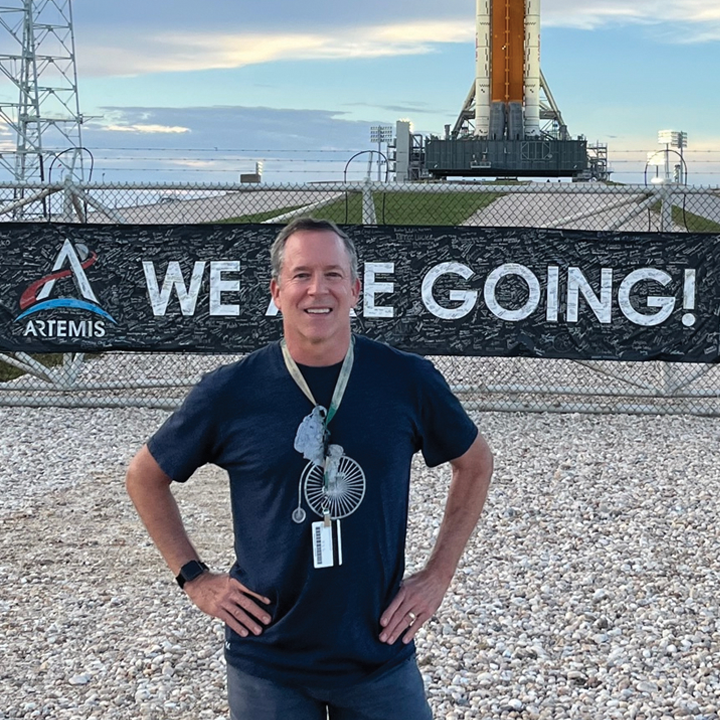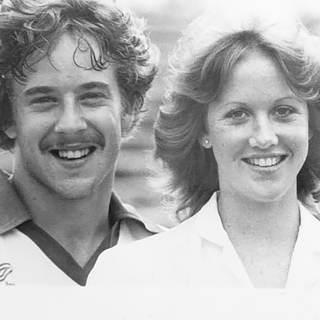Department
Rocket Man: A former Bulls soccer star is at the helm of Artemis 1, NASA’s most powerful rocket ever.

By DAVE SCHEIBER | for USF Advancement
IT WAS ONE OF THOSE SEEMINGLY MUNDANE moments that can completely alter a person’s flight path in life. For Rick LaBrode, it came in December 1984 with an impromptu decision that would turn his winter break into a career break beyond any heights he ever imagined.
Rather than fly home to St. Louis as usual for Christmas vacation, the USF junior instead joined his family in Houston for the holidays. His father had just taken a job as a NASA contractor for Ford Aerospace after retiring from the Army as a lieutenant colonel. At the last second, LaBrode chose to tag along with his dad to a company Christmas party as a fill-in for his mother.
“My mom thought it was best she didn’t go because my grandmother, who was also visiting, didn’t feel well,” he recollects. “So my dad asked me if I wanted to go, and I said, ‘Heck yeah,’ because I didn’t know anyone in Houston. There was nothing else for me to do.”
At the time, LaBrode was an electrical engineering major and a member of the Bulls’ standout soccer team, which often scrimmaged at USF against the original Tampa Bay Rowdies and once climbed to No. 2 nationally.
Little did he know his future course would make a dramatic ascent as well — ultimately putting him on track to lead NASA’s biggest space mission in 50 years, with its most powerful rocket in history.
Attending the party turned out to be the T-minus zero moment that launched LaBrode, ’85, Life Member, on a space odyssey with deep USF ties: His wife of 37 years, Kathy Blow LaBrode, ’83, Life Member, several of their sisters, and daughter Alexis, ’14, are all Bulls. It would eventually propel him to the Johnson Space Center, where he’s now the flight director of the historic Artemis 1 project, 10 years in the making and aimed at establishing a long-term human presence on the moon and, ultimately, missions to Mars.
On Nov. 16, after several last-minute delays, Artemis embarked on a 25-day, uncrewed mission to the moon. In 2024, it will make a 42-day voyage with a manned capsule, putting humans on the lunar surface for the first time since the final Apollo mission in 1972.
Now back to that pivotal party. Ford Aerospace’s personnel manager hosted the event and struck up a conversation with the young stranger, who explained that he was studying global electrical engineering at USF.
“I remember he said, ‘Wow, that’s great — when you graduate, give me a call and I’ll get you a job,’ ” LaBrode recalls. “I thought it was just polite small talk, but about a month later back at USF, I got a call. And he said, ‘Hey, I have a summer job opening up if you want it.’ ”
LaBrode had to turn it down — he had state-required summer credit hours to fulfill for graduation. But the manager was undeterred and offered to fly him to Houston in the spring for some preliminary job interviews.
“Sure enough, they flew me in and within two weeks of returning to school, I received a job offer,” LaBrode says. “It was incredible — I had a job lined up before I even started my last semester at USF.”
He thought of the many times he had watched from Tampa as space shuttle flights launched from Cape Canaveral, streaking across the sky. He never dreamed that he would be part of the team that made that magic happen.
“I didn’t think I was smart enough to work for NASA,” he says. “But I was in the right place at the right time.”
Now in his 37th year with NASA, LaBrode has climbed to the pinnacle of a distinguished career — with the whole world watching.

His friends and neighbors are hanging on every new Artemis development. Former classmates have reached out to Kathy on social media with well-wishes and prayers for success. When an interview with NBC News’ Tom Costello aired before the first postponement in September, LaBrode was deluged with messages.
“Everyone started coming out of the woodwork to wish me luck,” he says with a laugh. “A guy who moved in across the street said, ‘I knew you worked for NASA but this is incredible. I think I need your autograph!’ ”
LaBrode’s remarkable ride began as the youngest of five children, living in France, Germany, Virginia, Texas and Tampa due to his dad’s military career. The family settled in St. Louis when he was in second grade and he went on to play American Legion baseball, become an All-Conference soccer player and develop an interest in engineering. One of his teachers, Al Trost, had played for the St. Louis Stars of the North American Soccer League. He liked LaBrode and made a call to Dan Holcomb, then USF’s soccer coach, to talk him up.
That led LaBrode to USF in 1980, where he made the soccer team as a walk-on, playing all four years as a forward, midfielder and defender. He moved into Fontana Hall, then a USF off-campus co-ed residence hall, and quickly noticed a nursing student two years his senior in a suite across the hall, Kathy Blow.
LaBrode had a girlfriend in St. Louis, and Blow had a boyfriend in her hometown, Jacksonville. But by October of LaBrode’s freshman year, they were dating and things progressed steadily from there.
“July 1985 was an interesting month,” he says. “On July 1, I turned 23, On July 12, I graduated. On July 20th we got married. And on July 29, I started at NASA.”
• • •
After settling in Houston, Kathy found work at a hospital and eventually transitioned to medical education. The couple had two children, Alexis and Patrick. Kathy went to work as a nurse at their elementary school — a job she held for 18 years before retiring in 2021.
Patrick would eventually enroll at the University of Texas, competing as a Division 1 swimmer, but Alexis gravitated to USF and the chance to perform as a SunDoll. To her parents’ delight, she wound up at their alma mater as a double major in communications and religious studies — and a SunDoll all four years.
All the while, Kathy has marveled at her husband’s easy-going manner and balanced approach to life “He’s a truly nice guy and that’s what initially attracted me to him,” she says. “He loves his family. He loves his church. He loves physical fitness. And he loves his job.”
LaBrode started off as a shuttle flight controller in instrumentation and communications, knowing everyone’s systems and responsible for all audio, telemetry and video commands with the shuttle crew. He worked 51 missions over 13 years, but aspired to become a flight director. That wasn’t an option, since he was a contractor for Ford Aerospace, and only civil servants were eligible to be flight directors.
When NASA suddenly opened the role to contractors in 1998, he applied and became the first contractor ever selected, soon transitioning to civil servant. The timing couldn’t have been better as LaBrode worked extensively on the International Space Station in 2000, traveling to Moscow as flight director for the joint Russia-U.S. mission. He then became lead flight director for Expedition, which took astronauts to the space station.
LaBrode worked the final three space shuttle missions before the program ended in 2011, but joined a new project, Constellation, aimed at returning to the moon via a new space vehicle, Orion. Constellation was cancelled in 2010, but Orion survived and that gave way to Artemis. LaBrode has served as the Artemis 1 flight director since its first test flight in 2014, respected by colleagues and known for his unflappable demeanor under pressure.
“If you were to come to the Johnson Space Center and talk to anyone who knows Rick, they would tell you he’s the most calm, collected, and considerate leader,” Kathy says. “You’d never know he’s in the middle of the biggest mission of his life.”
• • •
LaBrode has experienced butterflies as past missions neared, but says he’s supremely confident with Artemis 1.
“Maybe it helps that I’m a really laid-back kind of person, kind of a Type C,” he says with a laugh. “We’ve been doing this for so long and I have such a good team. We’re all so prepared.”
For the Artemis 1 flight, LaBrode, who lives six miles from the space center, follows a highly detailed routine. One of his team members will handle the launch, and he’ll take over after the first 18-minute “burn” — firing a rocket motor to change trajectory — and supervising for 25 days, including a 37,000-mile orbit around the moon, until the splashdown expert takes over.
It’s all in a day’s work for the USF alumnus whose own trajectory changed in a big way with that fateful decision to attend a Christmas bash with his dad.
“That’s what opened the door to NASA,” he says. “And this mission is truly the pinnacle of my career.”